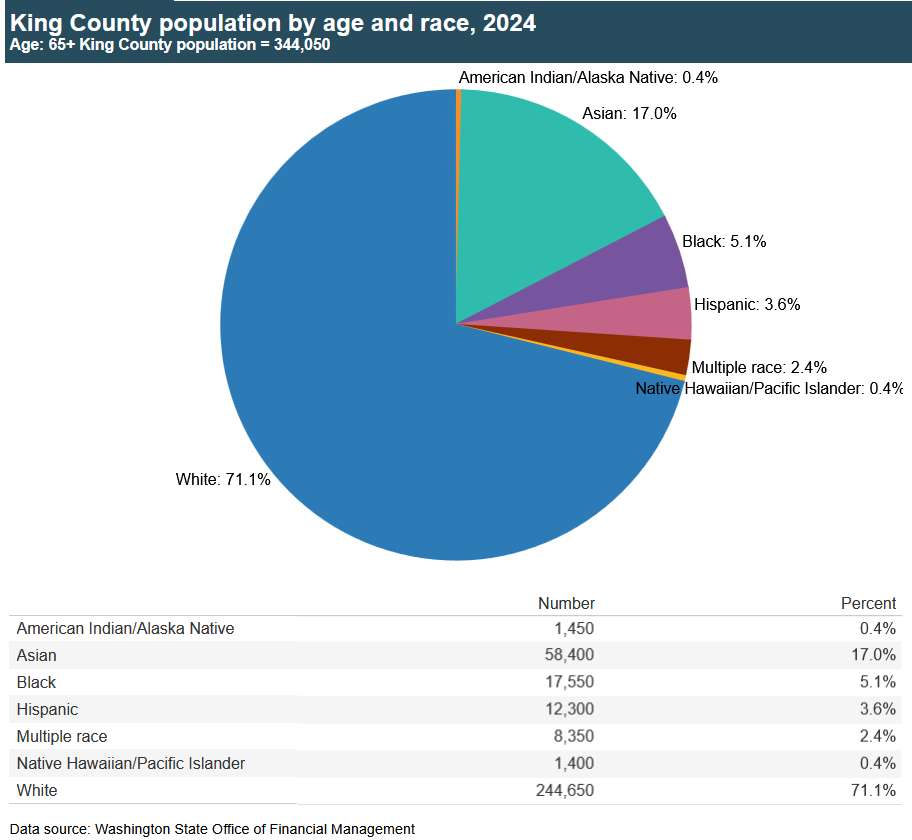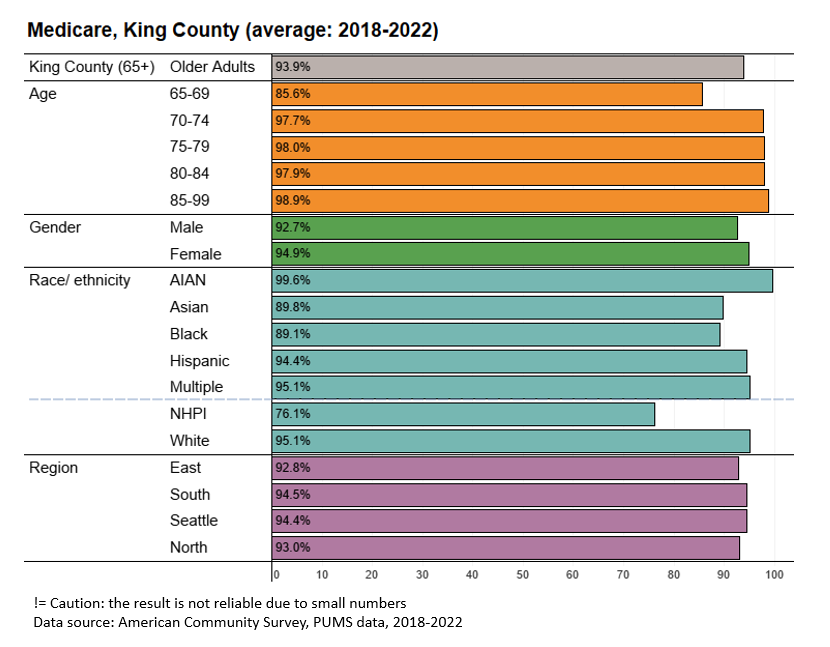Older Adults in King County: Prioritizing Health, Equity, and Support Across the Lifespan
Communities Count is excited to share the recent release of the Health of Older Adults in King County chart pack—a data resource that sheds light on the wellbeing, needs, and strengths of older residents in our community. This data resource developed by Public Health—Seattle & King County and the Communities Count Team offers a comprehensive overview of how local older adults, broadly defined as those aged 65 and older, are doing across social determinants of health, health care access, chronic disease, and end-of-life outcome indicators.
With King County’s aging population growing in number and diversity, these data are critical for shaping policies, programs, and partnerships that promote equity and ensure all older adults can live healthy, fulfilling lives.
Understanding the Landscape: Growth, Diversity, and Health Equity
Older adults (age 65+) make up about 14% of King County’s population as of 2024, with numbers that increased 36% since 2015. Importantly, nearly 1 in 3 older adults identify as people of color, and about 22% are foreign-born—underscoring the need for culturally and linguistically responsive services.
King County has seen a steadily growing population of older adults of color, including a diverse and multilingual community of older adults. 1 in 5 older adults speaks a language other than English at home, and about 8% have limited English proficiency—highlighting the importance of culturally and linguistically inclusive services, especially in healthcare and emergency situations.
Economic and Housing Insecurity: Uneven Impact Across Populations
The median income for older adults is higher in King County than the national average, but costs of housing, healthcare, food and transportation still pose a significant burden for lower income older adults. About 1 in 5 older adults in King County live below 200% of the federal poverty level—a threshold considered necessary to meet basic needs. However, stark inequities persist, especially for older adults of color, women, and American Indian/Alaska Native older adults, who face economic insecurity perpetuated by systemic discrimination, exclusion from education and economic opportunities, and lower than average lifetime earnings.
Housing affordability is another pressing issue for older adults. Around 35% of older adults are considered housing cost burdened, spending more than 30% of their income on housing. Renters, women and people of color, specifically American Indian/Alaska Native, Black, Hispanic and Multiple race older adults, are more likely to be housing cost burdened and thus more vulnerable.
Food and Health Insurance Access: Progress and Gaps
Food security remains a concern, especially for older adults with the lowest incomes—43% of older adults making under $20,000 annually reported running out of food without the means to buy more. Meanwhile, SNAP (Basic Food) enrollment increased in King County from 2022 through early 2025. Nearly 10% of older adults in King County reported receiving SNAP benefits from 2018-2022. This rate is higher than the overall county rate of 8% and higher than the rate for all other age groups. Many SNAP-eligible older adults, however, remain unenrolled.
Nearly all older adults (65+) in King County have health insurance (99%), primarily through Medicare.
Dental care remains a challenge, however, with nearly 1 in 4 older adults in King County lacking a dental checkup in the past year, particularly among lower-income older adults. Medicare provides limited coverage of dental care, and many older adults need supplemental insurance to cover preventive dental care. Access to preventive care like dental services is crucial for the overall well-being for older adults.
Managing Chronic Conditions: Risks and Resilience
More than half of older adults (56%) in King County live with multiple chronic conditions and 27% have a disability. Older adults had higher rates of hypertension and diabetes than did younger adults.
Chronic physical conditions pose significant challenges, though the mental health of older adults presents a more complex picture. Older adults report lower levels of frequent mental distress than their younger counterparts—which suggests resilience, unless stigma influenced older adults to underreport distress. Mental health disparities persist, particularly among economically disadvantaged adults aged 65–74 with incomes below $20,000, one in four of whom reported experiencing frequent mental distress.
Aging in a Changing Climate: A Public Health Challenge
Older adults are especially vulnerable to climate-related health risks and may experience greater adverse impacts from extreme weather events like the hotter summers and wildfires seen over recent years. During the 2021 heat dome in King County, adults 75 years and older experienced the highest rates of heat-related emergency visits. The rate of asthma-related emergency department visits among adults 75 years and older increased from 2019 to 2023. This trend is expected to continue as extreme weather events become more frequent.
End of Life: Causes of Death and the Ongoing Impact of COVID-19
From 2020 to 2022, the top causes of death among adults ages 65 and older in King County were heart disease, cancer, Alzheimer’s disease, stroke, and COVID-19. Notably, COVID-19 was the second leading cause of death for Native Hawaiian/Pacific Islander older adults and third for Hispanic older adults, highlighting racial disparities in health outcomes.
Moving Forward: From Data to Action
The Health of Older Adults in King County emphasizes the need for continued investment in services and systems that support older adults, especially older women and older adults of color who disproportionately face economic hardships, housing insecurity, language barriers and limited access to health and well-being resources. Solutions must be rooted in equity and informed by the lived experiences of our aging population in King County.
Everyone—families, service providers, policymakers, and community organizations—has a role in ensuring that aging in King County is marked by dignity, opportunity, and health. By turning this data into action, we can build a community where all older adults thrive.
For more data and findings about older adults in King County, please see the full The Health of Older Adults in King County Chart Pack.





